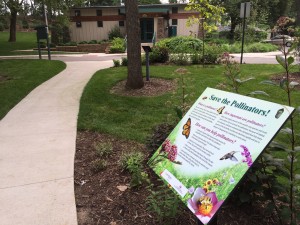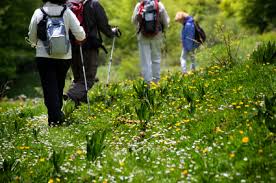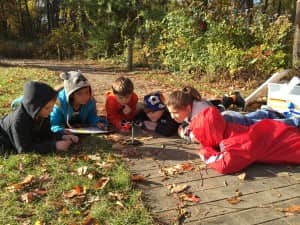Tree Walk at Gentile Park
Hello, I am Stella Toth! After 13 years as a Girl Scout, I will graduate in 2025. I completed this “Tree Walk” at Gentile Park as part of my Girl Scout Gold Award, the highest award a scout can achieve. The “Tree Walk” is designed to teach the community about trees native to the area. This is important because our ecosystem is deteriorating, and the loss of native plants is a huge part of the reason why. Education is the first step towards change, so I thank you for visiting my project and taking the time to learn about native plants!"
Trees that you will find:
Catalpa: With its huge heart-shaped leaves — 6 to 12 inches long and 4 to 8 inches wide — this guy will cast a very dense shadow. In May and June, beautiful, slightly fragrant bell-shaped orchid-like flowers will appear in 4- to 8-inch panicles and soon be visited by hummingbirds, honeybees and other pollinators. These flowers will then give way to the fruit or pods that can be up to 20 inches long and persist well into the winter months until it eventually splits open to release the many flat-winged seeds.
Cottonwood: The leaves of the Cottonwood tree provided both nourishment for livestock and shade for early settlers. Its trunks were often carved into canoes, while the
bark served as horse forage and as a base for a bitter medicinal tea. The trees also acted as communal meeting spots and were used as markers along trails. In the 19th century, the Union Pacific Railroad utilized Cottonwood timber for cross ties in constructing its railroad tracks.
Before long, it will feel like snow is falling. In northern Ohio, the weather can be unpredictable, and those delicate tufts of cotton drifting through the air give the illusion of snowflakes, even though it’s summer. These are actually the cotton-like fibers surrounding the seeds of the Cottonwood tree..
Hickory: Hickory trees are found throughout North America, from Canada to Mexico, thriving in every USDA hardiness zone. They flourish in moist, rich soils, typically found at the base of hilly slopes or along the edges of forests.
This species is highly valuable for its wood, nuts, and sap. The sap is often turned into a syrup with a rich, complex flavor. While hickory trees provide many benefits for humans, they also play a crucial role in the ecosystem, supporting a variety of wildlife and serving as hosts for numerous butterflies and moths. Hickory nuts are a great source of dietary fiber, monounsaturated fatty acids, B vitamins, and minerals such as manganese, zinc, and phosphorus.
These nuts can be eaten as a snack or used as an ingredient in various desserts and industrial candies. Additionally, the bark of the shagbark hickory is tapped to produce edible syrup.
Sycamore: The sycamore tree is the largest deciduous tree in the Eastern United States, reaching heights of up to 30 meters and living for nearly 600 years. Its wood is valued for making items like musical instruments, butcher blocks, and furniture. The sycamore is also a popular choice for providing shade and is commonly planted in parks and large gardens. Mature trees are highly wind-resistant, making them suitable for coastal and exposed areas as windbreaks. Additionally, their tolerance to pollution makes them ideal for urban environments as street trees. Beyond its practical uses, the sycamore offers food and shelter to a variety of wildlife species.
Oak: Oaks are considered "keystone" species, meaning their presence is crucial to the survival of many other plants and animals. Species like red-headed woodpeckers and squirrels rely on the large cavities of oak trees to raise their young. Over 500 species of insects live on and feed from oaks, providing a vital food source for insect-eating migrants like Wilson's warblers, American redstarts, and common yellowthroats as they pass through.
The oak is also the national tree of the United States. In 2001, the National Arbor Day Foundation held a nationwide vote, and the oak emerged as the winner. Oaks symbolize strength and endurance.
An oak can absorb up to 50 gallons of water in a single day, making them valuable in flood-control efforts. However, only about one in 10,000 acorns will grow into a tree. While many animals like deer and squirrels consume acorns, those that aren't eaten need specific conditions to sprout, including a period of four to eight weeks at certain temperatures. If the weather is too hot or too cold, the germination process cannot begin.
During a storm, it's best to avoid standing under an oak. While lightning can strike any tree, oaks seem to be hit more frequently. Some scientists believe this is because oaks are often the tallest trees, while others suggest their rough bark may trap more moisture, making them better conductors of electricity.
Wildlife can be selective when it comes to acorns. Oaks are divided into two groups: white (including white, swamp white, bur, and chinquapin) and red (including northern red, pin, and black). White oak acorns are lower in tannins, making them more palatable to wild animals. When white oak acorns are scarce, animals will turn to red oak acorns, though they aren't as favored.
Walnut: Walnut trees are fascinating for a few reasons: their nuts are considered one of the oldest tree foods known to humans, their scientific name "Juglans" links them to the Roman god Jupiter, the shape of the walnut resembles a human head, and their wood is highly prized for its quality and appearance; ancient civilizations even used walnuts to make "walnut milk" as a beverage.
There are about 20 different types of walnut trees. They are native to North and South America, southern Europe, Asia, and the West Indies. They grow best in sunny valleys and other lowlands with moist soils. The most valuable types of walnut trees in North America include the black walnut, which is prized for its beautiful, fine-grained wood and sweet, oily nuts, and the English walnut, which produces the nut most commonly sold as a shelled or unshelled walnut in grocery stores.
Redbud: George Washington was enamored with the redbud tree and actually transplanted some from the woods to his garden at Mount Vernon.
Known as the harbinger of spring, the Eastern Redbud’s delicate blossoms and buds are one of the season’s most dramatic displays. But this tree’s beauty doesn’t end with its flowery show. Unique and irregular branching patterns combine with a trunk that commonly divides close to the ground to create a very handsome, spreading and often flat-topped crown.
Environmental Education
The environmental education program is continuing to grow and evolve. What began in 2003 as the Land Lab Nature Program with the Kettering City Schools has greatly expanded in recent years. In April 2013, the Habitat Environmental Center was completed, and was the final project of the 2008 Bond Levy. We are pleased to have this facility to greatly expand our environmental education programming for the community. We offer year-round programs, so be sure to check out what we’re offering this season.



Habitat Environmental Center and Environmental Education Programming
3036 Bellflower St.
Kettering, OH 45409
Managed By: Kerri Miles
937-296-2477
Kerri.Miles@Ketteringoh.org
General Questions or Inquiries may be directed to habitatcenter@Ketteringoh.org
Mission
To engage and educate, advancing environmental literacy and creating a more equitable and sustainable future.
Vision
We will foster stewardship behavior and create a culture that capitalizes on nature-based recreation, cultivating bonds to place and enhance the Kettering community.
Values
Through current and quality education opportunities, encourage environmental stewardship to reduce environmental impacts and promote sustainability.











